
shortSnackBar (message: String, action: ( Snackbar. So, I just have all three of these and use them in appropriate cases. You could just use the context version of the function, but since it is Context and not Context? in fragments you would be calling the requireContext() function than the getContext() property. showToast (message: String, length: Int = Toast.LENGTH_SHORT) = Toast.makeText( this, message, length).show() showToast (message: String, length: Int = Toast.LENGTH_SHORT) = Toast.makeText(context, message, length).show()

Extension functions Toasts internal fun AppCompatActivity. Implementing as much functionality as possible in the shared module is better, even if doing so takes more time. The app runs, but once I try to click add, the app crashes hard. I originally had compile errors but was able to find modern syntax that allowed compile. It seems there are a lot of versions of Kotlin with different syntax. Use expected and actual declarations only for Kotlin declarations that have platform-specific dependencies. I've tried googling many different things and I just can't find anything specific to my issue.

This along with Android studio giving random auto complete suggestions makes it frustrating. The IDE provides tools that help you create the missing actual declarations. No one likes typing out Toast.makeText(context,"My message",Toast.LENGTH_SHORT).show(), takes too much time for something so simple. Kotlin main () function can be related to main () function in Java programming or C programming language. In the outermodule it can use the method_public() from DerivedClass, but it can't access the method_internal().Īnd it cannot make the method_internal as protected since it should allow access in everywhere in the core module.Are an awesome way to extract and clean up code in your Android project. The main () function in Kotlin is the entry point to a Kotlin program. In another module (the outermodule) it has a class which is derived from the BaseClass. The process of creating instances of nested, inner, and anonymous inner classes is described in Nested classes. In the app, whoever has dependency on the core module, the BaseClass can be used in the app, but in the app it cannot see the internal method_internal(). In the core module, the method_internal() can be accessed outside the BaseClass.

In the case that there are core modules, and another module (call it outermodule) which has a class derived from the class defined in the core module. In Kotlin when applying "internal" to the member function of a public class, it is only visible inside the module.


 0 kommentar(er)
0 kommentar(er)
